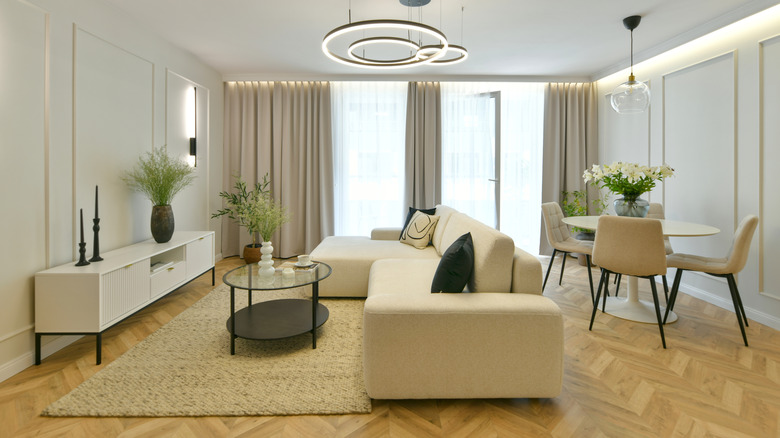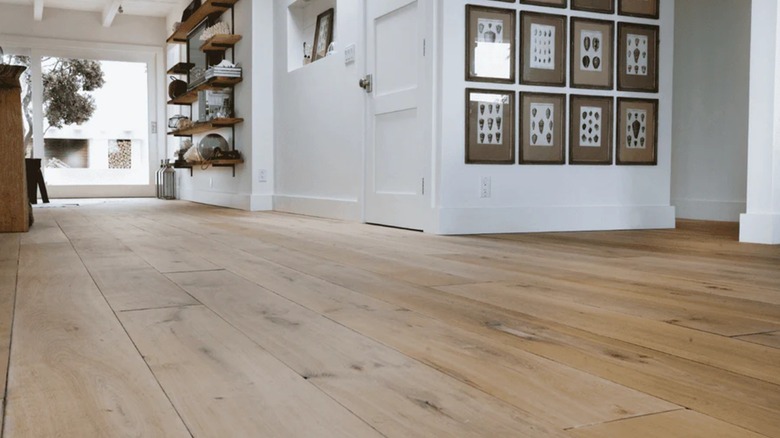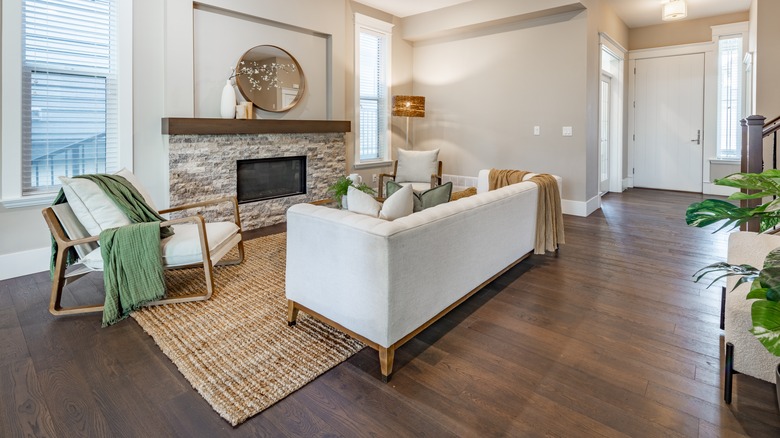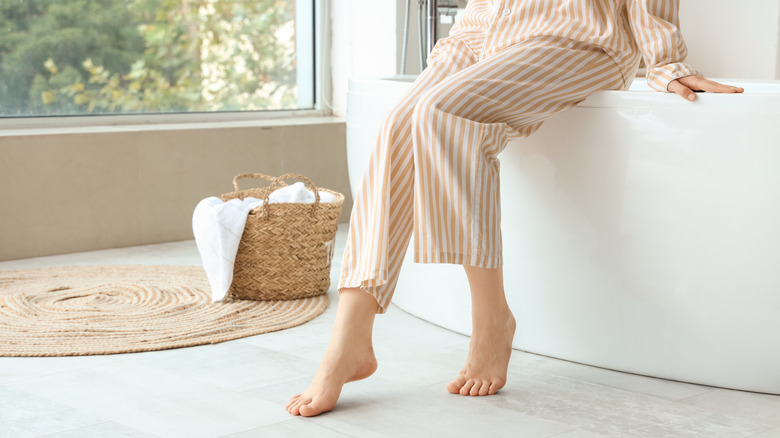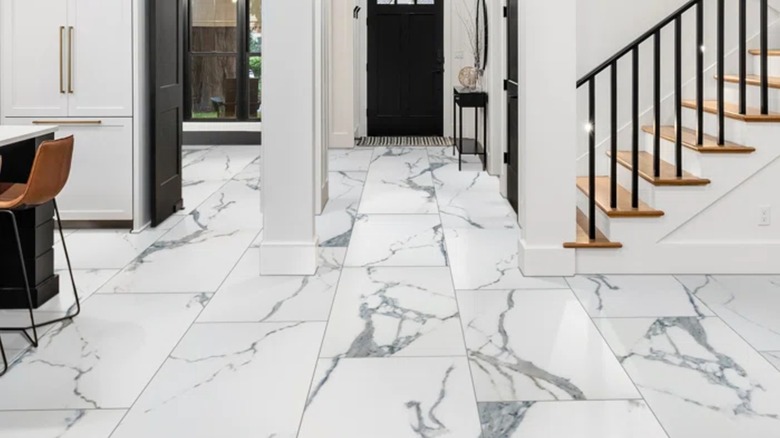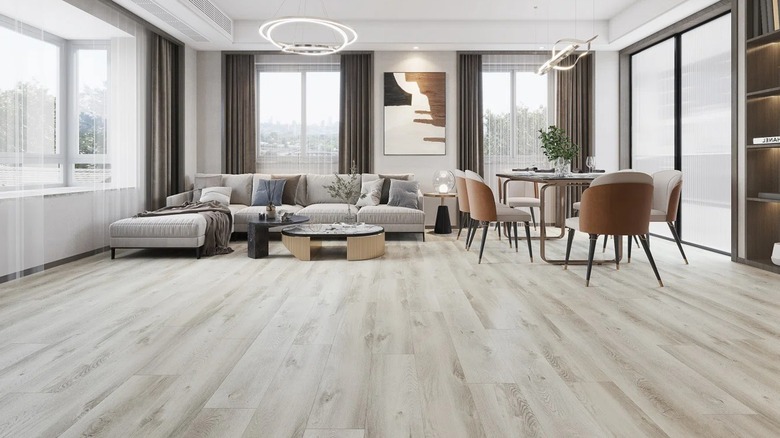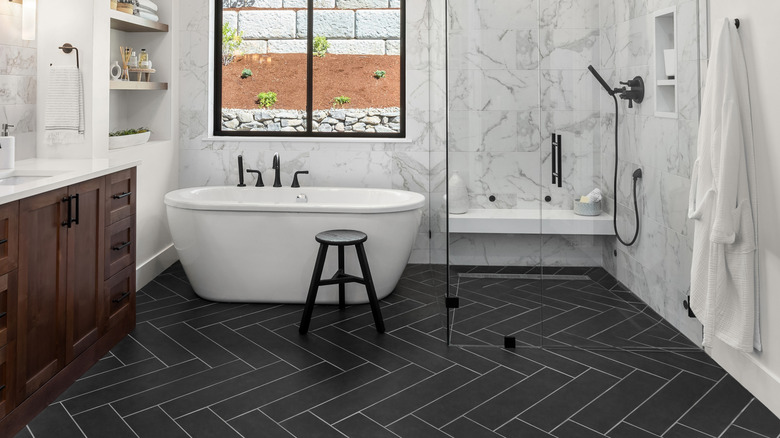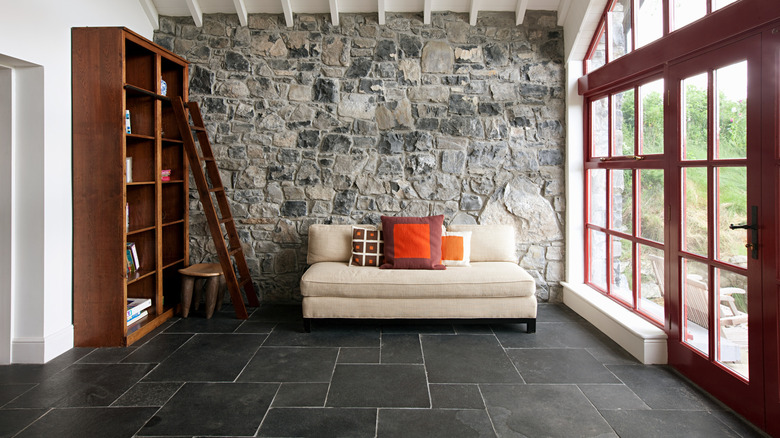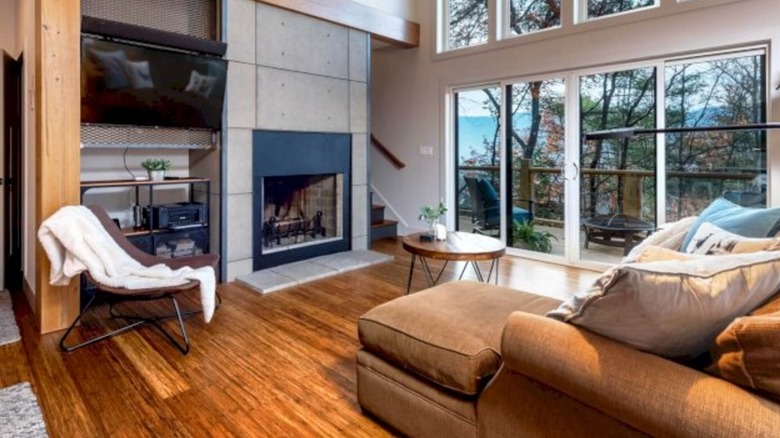6 Flooring Upgrades That Are Worth The Extra Cost (And 3 To Skip)
We may receive a commission on purchases made from links.
Upgrading the flooring in your home is no small undertaking. New flooring isn't cheap and can cost even more to install. If you've wandered through your local home improvement store or started some online research to decide what you want to get, then you've probably noticed the wide range of prices among different types of flooring. Some cost significantly more than others, so it's natural to wonder whether there really is any benefit in spending even more on one of these more premium options.
We were wondering the same thing. So, we reached out to several flooring and design professionals to get their expert opinions on which upgrades are actually worth the extra cost — as well as which ones you're probably better off skipping. Before you commit to purchasing new flooring for your home, read through the information these experts shared exclusively with House Digest. You just might learn something new to help you decide whether a particular option's higher price tag will bring added value to your home, both in terms of the actual resale value as well as the added beauty or ease of maintenance provided by the material.
You probably won't regret splurging on extra-wide hardwood planks
Hardwood floors require a significant investment, but in most cases, they're worth it. "Hardwood floors have been installed in homes for hundreds of years and will always be a welcome sight to future homeowners. While other materials like luxury vinyl and laminate try to mimic hardwood, there's nothing quite like the real thing." Courtney Wollersheim, an interior designer at FLOOR360, shares during an exclusive interview with House Digest. She highlights the longevity and eco-friendliness of solid hardwood options, noting how, unlike other options, hardwood can be refinished multiple times.
Martha Chatham Wakelin, the creative director at LX Hausys America, recommends upgrading to extra-wide hardwood planks. "These formats create a more seamless, expansive look, making rooms feel larger and more open," Wakelin tells House Digest in an exclusive interview. Beyond this benefit, Wakelin also notes that wider planks will deliver a higher-end look, "with many homeowners favoring the clean, continuous lines of fewer seams over traditional, narrower planks."
Of course, hardwood flooring comes with a higher price tag than imitation products, and you can expect to spend even more on extra-wide planks. Larger trees are needed to produce wider boards, which increases the cost. While prices may vary according to wood types, manufacturers, and other factors, wide planks can cost two or more times as much as narrower options. Extra-wide planks are also more susceptible to being damaged by moisture because of the fewer seams between the floorboards. If you are already dealing with moisture or humidity issues in your home, this flooring might not be the right choice. If you're looking for a DIY-friendly install, you also might be better off skipping extra-wide hardwood planks. Proper installation is key to make sure there are no gaps or cupping over time. However, wider planks are usually faster to install, which can save you some labor costs.
Engineered hardwood is worth the investment
While engineered hardwood floors typically don't cost as much as solid hardwood options, they are still a pricier upgrade compared to materials like LVP (often costing around double the amount per square foot of material). However, during an exclusive interview with House Digest, Iurii Kozak, home renovations contractor and founder at Kozak Renovations, says the investment is "worth every single penny." He explains some of the benefits to choosing engineered hardwood floors, including the fact that they counter some of the downsides of solid hardwood surfaces. "Engineered wood composites comprise multiple layers of plywood topped with a thin veneer of solid hardwood. This prevents [damage], rendering it impervious to humidity and temperature fluctuations, making it the best for basements or areas in other regions with highly humid conditions," he says. According to Kozak, engineered options also have a long lifespan, potentially up to 30 years. "Some will even take refinishing one or two times to extend their lifespan," he notes.
One additional benefit of choosing engineered over solid wood floors is the price. "It costs slightly less than solid hardwood, from $6 to $12 per square foot installed; nonetheless, it provides similar aesthetic appeal with fewer maintenance concerns," Kozak explains. However, there are also some downsides to engineered wood floors to consider. One is the overall lifespan. While engineered options can last for decades, and are considerably more moisture resistant, they still can't match the overall longevity of solid wood. Solid wood can be refinished up to seven times. You can't refinish engineered hardwood floors more than three times — and that's for the higher-quality options. It's only one or two times for cheaper planks. If a lot of natural sunlight reaches the surface of hardwood flooring, it may fade or darken more quickly. This can be problematic with engineered options simply due to the limited number of times you'll be able to refinish them. However, if you're yearning for the look and feel of real wood floors, need some added durability against dents and water damage, and are keen to save money on the install, engineered hardwood could be an ideal option.
Heated flooring is a luxurious upgrade that you'll be thankful for
Opting to install radiant floor heating is definitely a splurge. And you may be debating about whether it is really necessary or worth the high price tag. When speaking exclusively with House Digest, Courtney Cole, an interior designer at TileCloud, says, "If you're considering underfloor heating, especially beneath tiles in bathrooms, I would say go for it! Trust me, you will thank yourself every winter." Gordon Chalk, managing director at Next Level Underfloor Heating And Screed Solutions, concurs that radiant underfloor heating is well worth the cost. "It gives off even, steady heat that is very warm," he explains during an exclusive interview with House Digest.
So, how much do heated floors cost? While the price will vary based on the size of the room and the specific system you choose, you should expect to spend a minimum of $1,500 — but possibly more than $6,000 — on this flooring upgrade. While radiant floor heating is certainly not cheap, Chalk brings up an often overlooked point that may help offset the cost: Underfloor heating is energy efficient. According to Chalk, "It also gets rid of cold spots and lets you lower the temperature overall, which can help lower your energy bills. Plus, it's a secret way to heat your home that saves room." Radiant floor heating is estimated to be up to 25% more efficient than systems that use forced air. Before you pull the trigger, Chalk advises homeowners "get several quotes and look into the pros and cons of different types of heating systems (electric vs. hydronic) to find the most energy-efficient choice." He also notes that this is not a DIY-able job. If you want to learn more, we have a guide on what to know before you invest in radiant floor heating.
Large format tiles deliver several benefits that are worth their added cost
Whether you're looking to lay a tile floor in your kitchen, bathroom, or entryway, you might want to pay the extra cost and go with a large format style. Cole highlights large format tiles as both a practical and attractive option, saying, "One of my go-to recommendations is going for large-format tiles, especially for kitchens and bathrooms. If you have bigger tiles, it means you will have fewer grout lines." The designer explains that having a minimal amount of grout lines can not only make the space feel bigger, but it also leaves fewer grooves for grime to accumulate and drive you nuts.
Thanks to various factors, bigger tiles can come with a higher price tag. While you might assume that installation would be easier, since there are fewer tiles to lay, the opposite is actually true. Larger tiles are more challenging to place because of the extra care that is required to prevent them from cracking, and most tilers charge extra for these installs. If you're looking for a DIY option, large format tiles are not the right choice. They're heavier and more difficult to work with and are more likely to crack if you make an installation error. As far as the actual price of the tiles goes, this can vary widely, with large format styles costing anywhere between $0.89 to $44 per square foot. If you have your heart set on a luxe-looking large format tile floor, but weren't banking on the extra costs — you might be able to use this wiggle room to stay on budget. By opting for a cheaper tile in the lower end of the price range (like the Shandar Square 48-inch by 48-inch tile from The Home Depot for $4.42 per square foot, or MSI's Eden Statuary 24-inch by 48-inch Matte Porcelain Floor Tile for $4.88 per square foot) you might be able to free up enough of your flooring budget to cover the higher installation costs. If you're tiling a large bathroom floor or your whole house, buying tile by the pallet instead of per box could also help you cut down on costs.
The added cost of top-of-the-line LVP flooring will end up paying dividends
You might be considering luxury vinyl plank (LVP) flooring for your home. Two of our experts highlight it as a worthwhile investment. "LVP provides the beauty of real wood while delivering superior durability and moisture resistance, making it an excellent choice for kitchens and high-traffic areas. Its ability to mimic wood and stone textures with high-resolution prints and embossed finishes makes it a cost-effective yet stylish flooring solution," Wakelin explains.
However, something many people don't realize is that all LVP is not created equal. Kozak highlights the importance of choosing a top-of-the-line LVP option. These floors, he explains, "boast rigid core construction along with all the stability and comfort required for foot traffic." Kozak mentions CoreTec and Shaw Floorte as two manufacturers that anyone looking for the best quality LVP might want to consider. Higher-quality vinyl surfaces will have a thicker wear layer than cheaper options. Because of this, the flooring will have a longer lifespan. If you want the floors in your home to last, look for a wear layer that is at least 8 millimeters thick.
LVP products typically range in price between $2 and $5 per square foot (however very premium options can cost up to $7 per square foot). Shaw Floorte LVP planks range between $3-$4 per square foot. CoreTec LVP is slightly pricier, costing between $4-$5 per square foot. In short, you can expect to pay roughly double if you opt for high-quality LVP instead of the cheapest options — but you will get more life out of your new flooring and it will feel far better underfoot.
The elegance and sophistication of a herringbone pattern makes the cost worthwhile
While herringbone floors are beautiful, they are not exactly a budget-friendly upgrade. Despite this, Wakelin highlights them as one of her top recommendations "for those seeking a timeless and elegant flooring style." When used correctly, "this pattern adds sophistication and movement to a space, elevating its overall design appeal. It's a nod to classic craftsmanship but feels fresh and modern, particularly in open living areas," she explains. There are a few materials that are well-suited to use for herringbone floors — including tile and wood— so you'll be able to play with the material, color, and texture to meet your specific design needs and preferences.
You may wonder why herringbone styles rank as a pricier upgrade compared to hardwood or tile pieces installed in a more standard pattern. The reason these floors come at such a premium is due to the increased installation complexity. The pattern, which gets its name from a herring fish's skeleton, features V-shapes that meet at 90-degree angles, and requires some extra time and precision on the part of the installer. However, they can still be a cheaper option overall compared to chevron tile layouts. Chevron layouts feature 45-degree tile or plank ends that meet in a symmetrical V shape. While you can purchase chevron-shaped tiles, they tend to cost slightly more, and are often mainly available in smaller formats. If you want larger tiles or planks laid in a chevron pattern, each end may need to be cut to a 45-degree angle, increasing labor costs and material waste. Chevron hardwood flooring planks may be simpler to source, especially if you opt for engineered hardwood. Whichever route or material you choose however, the extra expense can be well worth it, as a more intricate installation will ensure your space feels anything but builder-grade. To keep costs under control, you might be able to pair up this more premium pattern with some simple tricks and tips to save money on your flooring installation.
Hardwood flooring might not be worth the investment in neighborhoods with lower house prices
While hardwood floors are recommended as a worthwhile upgrade for many homeowners, Jeff Thacker, a master tiler and owner of Jeff Thacker Master Tiler LLC, offers one important caveat. When speaking exclusively with House Digest, he says, "Hardwood floors typically offer the most resale value in higher-end homes, but the neighborhood matters. You have to keep track of what flooring [your] neighbors are upgrading to by looking at homes sold." He cautions against spending too much on an upgrade that might not trigger a good return on investment if similar homes in your area simply aren't selling for enough. The bottom line is that you should consider the cost of an upgrade, comparable home values in your neighborhood, and what you'll be happy living with — especially if you aren't looking to sell your home any time soon.
If home values in your area aren't high enough to justify the cost associated with hardwood flooring — or especially extra-wide hardwood planks — Thacker offers another option to consider. He says, "For middle-tier homes, luxury vinyl tile that looks like wood is a great upgrade. People like it because it's extremely durable and easy to clean and maintain." Besides being a budget-friendly alternative to hardwood, luxury vinyl tile is also the best bathroom flooring material for resale, according to Realtor Lindsey Schmidt. If you don't like products that merely mimic the look of wood, LVT, unlike LVP, also gives you the option to go with motifs other then imitation wood grain, such as slate, marble, and other stone-look patterns, or even an encaustic tile look, such as the MSI Rivello MIL Luxury Vinyl Flooring.
Avoid natural stone flooring if you're not prepared for the necessary maintenance and upkeep
Natural stone floors are an expensive upgrade that can come with a lot of benefits. Stone is inherently durable, so it can be a good choice for high-traffic areas that might otherwise get damaged. Natural stone is also known for its ability to help control the temperature during the warmer summer months by keeping the environment cool and comfortable. However, Cole cautions that an upgrade to natural stone flooring isn't for everyone.
One of the biggest drawbacks of natural stone surfaces (besides the steep price tag) is their maintenance requirements. "It's porous, which means it needs regular sealing, and it's also more likely to get stained than some of your alternatives," Cole explains. On average, a more porous stone like marble, sandstone, or travertine will need resealing every year or so. If you don't reseal your floors regularly, this will increase the chances of stains, marks, and etching. Choosing the right cleaning products can also be more difficult with natural stone floors. For instance, there are some natural stone floors you can't use vinegar on, such as marble, because of its high acidity levels. If you aren't ready to commit to the necessary maintenance and upkeep, Cole suggests considering alternatives. "If you love the look, maybe think about getting porcelain tiles that mimic natural stone. You'll get the same aesthetic with much less stress!" she says. If you have your heart firmly set on natural stone, but don't feel like the hassle of having to reseal it every year, opting for a less porous stone like slate could be a good compromise.
Stay away from pricey handscraped finishes that no longer match modern design trends
A few years ago, you may have been told that installing handscraped flooring was a worthy investment. However, times change and so does the advice that design experts offer. Wakelin recommends against this flooring option. "While they were once popular for their rustic charm, these heavily textured surfaces are falling out of favor," she explains, adding that smoother finishes in hardwood flooring have taken over. Besides being out of fashion, handscraped planks are impractical, as "the deep grooves can also trap dust and dirt, making them harder to maintain over time," Wakelin warns.
Beyond it not matching more refined and modern design trends, there are a few other downsides that may fully put the nail in the coffin for handscraped finishes. First, they are not cheap. While you can get hardwood flooring installed for less than $10 per square foot, you may spend up to twice as much for handscraped options. This is because of the amount of labor that is required to produce these floors — they are scraped by hand, after all. If you're trying to increase y your home's future resale value, you may also want to reconsider handscraped finishes. Unless you happen to find a buyer who is specifically looking for a more farmhouse or rustic look, you may turn away anyone who desires something more timeless or modern.
